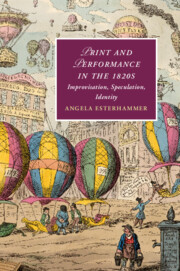Book contents
- Print and Performance in the 1820s
- Cambridge Studies in Romanticism
- Print and Performance in the 1820s
- Copyright page
- Contents
- Illustrations
- Acknowledgements
- Chapter 1 Introduction: Being There, circa 1824
- Chapter 2 Periodical Performances
- Chapter 3 Mediating Improvisation and Improvising Mediation
- Chapter 4 Personal Identity, Impersonation, and Charles Mathews
- Chapter 5 Theodore Hook’s Sayings and Doings on the Page and the Stage
- Chapter 6 Speculating on Property
- Chapter 7 Scottish Fictions of 1824
- Notes
- Bibliography
- Index
- Cambridge Studies in Romanticism
Chapter 4 - Personal Identity, Impersonation, and Charles Mathews
Who Is He When He’s at Home?
Published online by Cambridge University Press: 11 March 2020
- Print and Performance in the 1820s
- Cambridge Studies in Romanticism
- Print and Performance in the 1820s
- Copyright page
- Contents
- Illustrations
- Acknowledgements
- Chapter 1 Introduction: Being There, circa 1824
- Chapter 2 Periodical Performances
- Chapter 3 Mediating Improvisation and Improvising Mediation
- Chapter 4 Personal Identity, Impersonation, and Charles Mathews
- Chapter 5 Theodore Hook’s Sayings and Doings on the Page and the Stage
- Chapter 6 Speculating on Property
- Chapter 7 Scottish Fictions of 1824
- Notes
- Bibliography
- Index
- Cambridge Studies in Romanticism
Summary
Throughout the 1820s, actor Charles Mathews performed popular evenings of character impersonations that he called “At Homes.” Exemplifying the fascination with personal identity, Mathews’s performances show how the identity of individuals and character-types could be made both recognizable and reproducible through the iteration of markers such as facial expression, accessories, voice, accent, and tag lines. His identity-bending performances are typical of their age in the way they reproduce philosophical ideas about personal identity derived from the Enlightenment in an embodied and experiential form that highlights the performative and commodified nature of identity. Mathews structured his performances around his own stabilizing personality as host and narrator and, in later years, modelled them on the print genre of the literary annual. Nevertheless, he also practised impersonations beyond the stage in private life. The proliferating identities he created on and off the stage were so credible as to make eyewitnesses believe he actually became the people he personified and thus to raise disturbing questions about the stability of identity.
Information
- Type
- Chapter
- Information
- Print and Performance in the 1820sImprovisation, Speculation, Identity, pp. 85 - 111Publisher: Cambridge University PressPrint publication year: 2020
